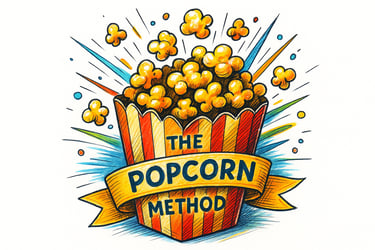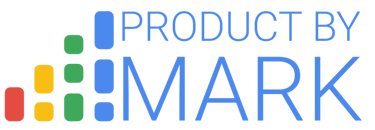The Popcorn Method℠: How to Turn Your Product Manager Interview Into an Engaging Show
Transforming technical interviews from robotic recitations into compelling narratives
Mark Rose
6/26/20254 min read
Picture this: You're sitting across from a product manager interviewer, and they're literally eating popcorn while you present your solution. Sounds absurd? Maybe. But this mental image captures one of the most powerful techniques for acing product management interviews—what I call the Popcorn Method.
What Is the Popcorn Method?
The Popcorn Method is a mindset shift that transforms how you approach product management interviews. Instead of treating the interview as an interrogation or a checklist to complete, you reimagine it as entertainment. Your interviewer becomes an audience member, sitting back with popcorn, watching you put on an engaging show.
This isn't about being theatrical or over-the-top. It's about creating a narrative flow that keeps your interviewer mentally engaged, leaning forward in their seat, thinking "okay, what happens next?"
Why Traditional Approaches Fall Flat
Most candidates approach product interviews like they're reading from a script:
"First, I'll clarify the problem"
"Next, I'll identify the target market"
"Then I'll analyze pain points"
"Finally, I'll propose solutions"
While structurally correct, this approach feels mechanical and robotic. Your interviewer has heard this exact sequence dozens of times. Their eyes glaze over. They start thinking about their next meeting.
You've lost them—not because your content is wrong, but because your delivery lacks narrative tension.
The Power of Transition Statements
The secret weapon of the Popcorn Method is the transition statement. These are the moments between framework steps where you explicitly connect the dots and build anticipation for what's coming next.
Instead of: "Now I'll look at pain points."
Try: "Okay, now that we know we're going to focus on families, let's explore their pain points and desires so that we can create a better shopping experience via more powerful human connections."
See the difference? The second version:
Reminds the audience where we've been
Explains why we're taking the next step
Connects back to our core objective
Creates anticipation for the exploration ahead
Real-World Example: The Grocery Shopping Case
Consider this transition from a real coaching session:
"Now that we're going to focus on families, let's explore families' pain points and desires so that we can create a better shopping experience via more powerful human connections."
This single sentence accomplishes multiple goals:
Recaps progress: "Now that we're going to focus on families"
Sets up the next section: "let's explore pain points and desires"
Reinforces the goal: "better shopping experience"
Maintains strategic focus: "via more powerful human connections"
Your interviewer thinks: "Great, this is building logically. I'm curious what pain points they'll uncover."
How to Implement the Popcorn Method
1. Start with Narrative Architecture
Before diving into frameworks, think about the story you're telling:
What's the journey your interviewer will go on?
What discoveries will you make together?
How does each section build toward a compelling conclusion?
2. Master the Art of Transition
Practice these transition techniques:
The Bridge: "Now that we've established X, let's explore Y so we can achieve Z"
The Question: "So how might we craft a solution that enables families to try something new?"
The Revelation: "This insight changes everything—let's see where it leads us"
3. Create Moments of Discovery
Don't just present findings—discover them together:
Weak: "The target segment should be families because they have the most pain points."
Strong: "Looking at this through the lens of impact... teenagers don't really care about grocery shopping—I can't even get my own kids to go to the store! But families? This is a core primitive need. Shopping for a family is genuinely frustrating and time-consuming. This feels like where we can make the biggest difference."
4. Use Strategic Pauses
In the transcript, notice how the coach uses phrases like "Let me think..." or "Interesting question..." These aren't filler—they're strategic pauses that build anticipation and show thoughtful consideration.
Common Pitfalls to Avoid
The Mechanical Recitation
Problem: Following your framework like a robot Solution: Treat each step as a genuine exploration, not a predetermined outcome
The Premature Solution
Problem: Jumping to solutions before building the narrative foundation Solution: Trust the process—let the story unfold naturally
The Transition Skip
Problem: Jumping between sections without connecting the dots Solution: Always explain why you're moving to the next step and how it serves your goal
Practice Makes Perfect
The beauty of the Popcorn Method is that it can be practiced and refined. Try this exercise:
Record yourself going through a practice product case
Listen back and identify moments where you sound robotic or disconnected
Rewrite those sections with engaging transitions
Practice the transitions until they feel natural, not forced
The Meta-Benefit: It Helps You Think Better
Here's the surprising thing about the Popcorn Method—it doesn't just make your presentation better, it actually improves your thinking. When you're forced to articulate why each step connects to your overall goal, you naturally:
Stay more focused on the core objective
Avoid tangential rabbit holes
Build stronger logical connections
Develop more coherent solutions
Your interviewer isn't just entertained—they're witnessing genuinely better product thinking.
Beyond the Interview Room
The Popcorn Method isn't just for interviews. The same principles apply to:
Stakeholder presentations: Keep executives engaged with narrative flow
Team meetings: Help colleagues follow your reasoning
Product documentation: Write specs that people actually want to read
Customer conversations: Frame discussions as collaborative exploration
The Bottom Line
Product management is fundamentally about storytelling—whether you're crafting a product narrative, presenting to stakeholders, or communicating strategy. The Popcorn Method recognizes this reality and helps you become a more compelling storyteller.
Your interviewer wants to see great product thinking, yes. But they also want to enjoy the conversation. They want to feel engaged, curious, and excited about where your thinking leads.
So the next time you sit down for a product interview, remember: your interviewer is sitting there with popcorn, ready to be entertained. Don't just solve the problem—take them on a journey they'll remember.


Copyright 2024. All rights reserved. Privacy Policy. Refunds and Cancelations. Terms and Conditions.


